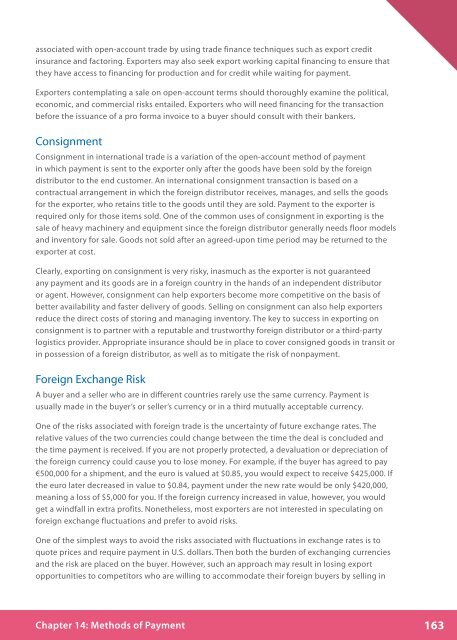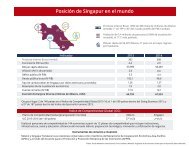basic-guide-to-exporting_Latest_eg_main_086196
basic-guide-to-exporting_Latest_eg_main_086196
basic-guide-to-exporting_Latest_eg_main_086196
You also want an ePaper? Increase the reach of your titles
YUMPU automatically turns print PDFs into web optimized ePapers that Google loves.
associated with open-account trade by using trade finance techniques such as export creditinsurance and fac<strong>to</strong>ring. Exporters may also seek export working capital financing <strong>to</strong> ensure thatthey have access <strong>to</strong> financing for production and for credit while waiting for payment.Exporters contemplating a sale on open-account terms should thoroughly examine the political,economic, and commercial risks entailed. Exporters who will need financing for the transactionbefore the issuance of a pro forma invoice <strong>to</strong> a buyer should consult with their bankers.ConsignmentConsignment in international trade is a variation of the open-account method of paymentin which payment is sent <strong>to</strong> the exporter only after the goods have been sold by the foreigndistribu<strong>to</strong>r <strong>to</strong> the end cus<strong>to</strong>mer. An international consignment transaction is based on acontractual arrangement in which the foreign distribu<strong>to</strong>r receives, manages, and sells the goodsfor the exporter, who retains title <strong>to</strong> the goods until they are sold. Payment <strong>to</strong> the exporter isrequired only for those items sold. One of the common uses of consignment in <strong>exporting</strong> is thesale of heavy machinery and equipment since the foreign distribu<strong>to</strong>r generally needs floor modelsand inven<strong>to</strong>ry for sale. Goods not sold after an agreed-upon time period may be returned <strong>to</strong> theexporter at cost.Clearly, <strong>exporting</strong> on consignment is very risky, inasmuch as the exporter is not guaranteedany payment and its goods are in a foreign country in the hands of an independent distribu<strong>to</strong>ror agent. However, consignment can help exporters become more competitive on the basis ofbetter availability and faster delivery of goods. Selling on consignment can also help exportersreduce the direct costs of s<strong>to</strong>ring and managing inven<strong>to</strong>ry. The key <strong>to</strong> success in <strong>exporting</strong> onconsignment is <strong>to</strong> partner with a reputable and trustworthy foreign distribu<strong>to</strong>r or a third-partylogistics provider. Appropriate insurance should be in place <strong>to</strong> cover consigned goods in transit orin possession of a foreign distribu<strong>to</strong>r, as well as <strong>to</strong> mitigate the risk of nonpayment.Foreign Exchange RiskA buyer and a seller who are in different countries rarely use the same currency. Payment isusually made in the buyer’s or seller’s currency or in a third mutually acceptable currency.One of the risks associated with foreign trade is the uncertainty of future exchange rates. Therelative values of the two currencies could change between the time the deal is concluded andthe time payment is received. If you are not properly protected, a devaluation or depreciation ofthe foreign currency could cause you <strong>to</strong> lose money. For example, if the buyer has agreed <strong>to</strong> pay€500,000 for a shipment, and the euro is valued at $0.85, you would expect <strong>to</strong> receive $425,000. Ifthe euro later decreased in value <strong>to</strong> $0.84, payment under the new rate would be only $420,000,meaning a loss of $5,000 for you. If the foreign currency increased in value, however, you wouldget a windfall in extra profits. Nonetheless, most exporters are not interested in speculating onforeign exchange fluctuations and prefer <strong>to</strong> avoid risks.One of the simplest ways <strong>to</strong> avoid the risks associated with fluctuations in exchange rates is <strong>to</strong>quote prices and require payment in U.S. dollars. Then both the burden of exchanging currenciesand the risk are placed on the buyer. However, such an approach may result in losing expor<strong>to</strong>pportunities <strong>to</strong> competi<strong>to</strong>rs who are willing <strong>to</strong> accommodate their foreign buyers by selling inChapter 14: Methods of Payment163





